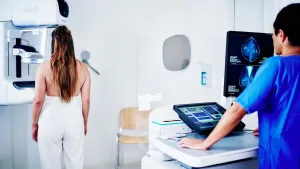
Breast diagnostics at the highest level - early detection, safer treatment.
85-90 % of breast cancers are due to genetic abnormalities. Screening tests, such as yearly mammograms, are given routinely to people who appear to be healthy and are not suspected of having breast cancer. Their purpose is to find breast cancer early, before any symptoms can develop and when the cancer is usually easier to treat.
Dr. Kämpf, Prof. Dr. Ketelsen, Dr. Trübenbach and their team of highly qualified physicians regularly participate in the external quality assurance for curative mammography of the “Kassenärztliche Vereinigung” in order to offer you the highest quality.
Diagnostic Mammography.
Diagnostic mammography is an x-ray of the breast. Mammograms are acquired because of abnormal results from screening or after new clinical signs of a breast mass/ lump alerted by the patient or her doctor for further investigation.
Such clinical signs may include:
- A mass/ lump in the breast
- Changes in size or shape of the breast
- Breast pain
- Thickening of skin on the breast
- Nipple discharge
A diagnostic mammogram can help determine the cause of these changes and to evaluate the presence of breast cancer.
Breast Ultrasound.
The ultrasound uses inaudible, high-frequency sound waves to produce pictures of what is inside of the body, and it does not utilize ionized radiation. It is safe and painless. Breast ultrasound imaging is used to evaluate and further diagnose areas of concern involving the breast; for example, a newly detected breast mass/ lump. It is a useful adjunct to mammography, helping to determine if a lump or mass is a harmless fluid-filled cyst or a solid abnormality which may require further investigation. However, it cannot be used as a replacement for a mammogram since (micro)calcifications (often the earliest sign of a breast cancer), do not usually show up well on ultrasound. While there are some research projects currently being conducted to evaluate the ultrasound as a secondary screening test for masses in certain situations, this is not currently recommended. Therefore, at the moment Mammogram images are still mandatory to evaluate the entire breast.





